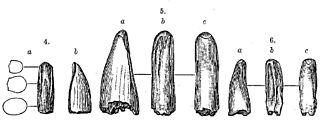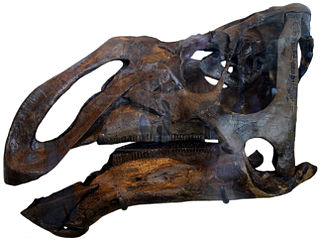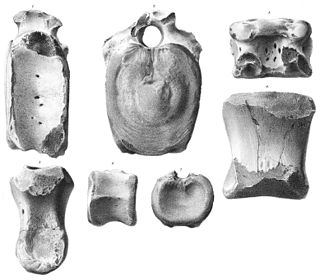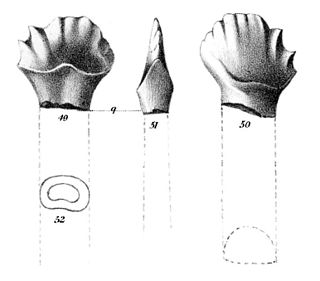
Trachodon is a dubious genus of hadrosaurid dinosaur based on teeth from the Campanian-age Upper Cretaceous Judith River Formation of Montana, U.S. It is a historically important genus with a convoluted taxonomy that has been all but abandoned by modern dinosaur paleontologists.

Hadrosaurids, or hadrosaurs, are members of the ornithischian family Hadrosauridae. This group is known as the duck-billed dinosaurs for the flat duck-bill appearance of the bones in their snouts. The ornithopod family, which includes genera such as Edmontosaurus and Parasaurolophus, was a common group of herbivores during the Late Cretaceous Period. Hadrosaurids are descendants of the Late Jurassic/Early Cretaceous iguanodontian dinosaurs and had a similar body layout. Hadrosaurs were among the most dominant herbivores during the Late Cretaceous in Asia and North America, and during the close of the Cretaceous several lineages dispersed into Europe, Africa, and South America.

Edmontosaurus, with the second species often colloquially and historically known as Anatosaurus or Anatotitan, is a genus of hadrosaurid (duck-billed) dinosaur. It contains two known species: Edmontosaurus regalis and Edmontosaurus annectens. Fossils of E. regalis have been found in rocks of western North America that date from the late Campanian age of the Cretaceous period 73 million years ago, while those of E. annectens were found in the same geographic region from rocks dated to the end of the Maastrichtian age, 66 million years ago. Edmontosaurus was one of the last non-avian dinosaurs to ever exist, and lived alongside dinosaurs like Triceratops, Tyrannosaurus, Ankylosaurus, and Pachycephalosaurus shortly before the Cretaceous–Paleogene extinction event.

Lambeosaurus is a genus of hadrosaurid dinosaur that lived during the Late Cretaceous period of western North America. The first skull of Lambeosaurus described was used by palaeontologist Lawrence M. Lambe to justify the creation of the new genus Stephanosaurus, but it was shown that this skull had to belong to a separate taxon, which William A. Parks named Lambeosaurus lambei in 1923, to honour Lambe. Multiple further species of Lambeosaurus have been named since, including L. clavinitialis and L. magnicristatus in 1935, and L. laticaudus in 1981 which was later moved to its own genus Magnapaulia. It has also been identified that some of the species of the genera Tetragonosaurus and Corythosaurus are juveniles of Lambeosaurus, including T. praeceps, T. cranibrevis, and C. frontalis. Lambeosaurus is the eponymous member of its subfamily Lambeosaurinae and tribe Lambeosaurini. Lambeosaurins, which also includes Corythosaurus and Hypacrosaurus from western North America, are understood to be some of the most specialized ornithopods.

Aublysodon is a genus of carnivorous dinosaurs known only from the Judith River Formation in Montana, which has been dated to the late Campanian age of the late Cretaceous period. The only currently recognized species, Aublysodon mirandus, was named by paleontologist Joseph Leidy in 1868. It is sometimes considered dubious now, because the type specimen consists only of an isolated premaxillary (front) tooth. Although this specimen is now lost, similar teeth have been found in many US states, western Canada, and Asia. These teeth almost certainly belong to juvenile tyrannosaurine tyrannosaurids, but most have not been identified to species level. However, it is likely that the type tooth belongs to one of the species in the genus Daspletosaurus, which was present in contemporary formations, and which matches specific details of the original tooth. The synapomorphies alleged to distinguish the Aublysodontinae, especially lack of serrations on premaxillary teeth could have been caused by tooth wear in life, postmortem abrasion, or digestion. Most other "aublysodontine"-type teeth may be from ontogenetic stages or sexual morphs of other tyrannosaurids.

Hypacrosaurus was a genus of duckbill dinosaur similar in appearance to Corythosaurus. Like Corythosaurus, it had a tall, hollow rounded crest, although not as large and straight. It is known from the remains of two species that spanned 75 to 67 million years ago, in the Late Cretaceous of Alberta, Canada, and Montana, United States, and is the latest hollow-crested duckbill known from good remains in North America. It was an obscure genus until the discovery in the 1990s of nests, eggs, and hatchlings belonging to H. stebingeri.

Gryposaurus was a genus of duckbilled dinosaur that lived about 80 to 75 million years ago, in the Late Cretaceous of North America. Named species of Gryposaurus are known from the Dinosaur Park Formation in Alberta, Canada, and two formations in the United States: the Lower Two Medicine Formation in Montana and the Kaiparowits Formation of Utah. A possible additional species from the Javelina Formation in Texas may extend the temporal range of the genus to 66 million years ago.

Kritosaurus is an incompletely known genus of hadrosaurid (duck-billed) dinosaur. It lived about 74.5-66 million years ago, in the Late Cretaceous of North America. The name means "separated lizard", but is often mistranslated as "noble lizard" in reference to the presumed "Roman nose".

Zapsalis is a genus of dromaeosaurine theropod dinosaurs. It is a tooth taxon, often considered dubious because of the fragmentary nature of the fossils, which include teeth but no other remains.

Stephanosaurus is a dubious genus of hadrosaurid dinosaur with a complicated taxonomic history.

Thespesius is a dubious genus of hadrosaurid dinosaur from the late Maastrichtian-age Upper Cretaceous Lance Formation of South Dakota.

Palaeoscincus is a dubious genus of ankylosaurian dinosaur based on teeth from the mid-late Campanian-age Upper Cretaceous Judith River Formation of Montana. Like several other dinosaur genera named by Joseph Leidy, it is an historically important genus with a convoluted taxonomy that has been all but abandoned by modern dinosaur paleontologists. Because of its wide use in the early 20th century, it was somewhat well known to the general public, often through illustrations of an animal with the armor of Edmontonia and the tail club of an ankylosaurid.
Dysganus (dis-GANN-us) is a dubious genus of ceratopsian dinosaur from the Campanian stage of the Late Cretaceous. The fossil teeth referred to Dysganus were first collected by Charles Sternberg from the Cretaceous Judith River Formation of Montana and later described by Edward Drinker Cope. All of the species are now seen as dubious Ceratopsians, though referred material from tyrannosaurids and hadrosaurids were found in New Mexico.

Mandschurosaurus is an extinct genus of hadrosaurids based on material from the Late Cretaceous of China and possibly also the Early Cretaceous of Laos. It was the first dinosaur genus named from China.

Prosaurolophus is a genus of hadrosaurid dinosaur from the Late Cretaceous of North America. It is known from the remains of at least 25 individuals belonging to two species, including skulls and skeletons, but it remains obscure. Its fossils have been found in the late Campanian-age Upper Cretaceous Dinosaur Park Formation in Alberta, and the roughly contemporaneous Two Medicine Formation in Montana, dating to around 75.5-74.0 million years ago. Its most recognizable feature is a small solid crest formed by the nasal bones, sticking up in front of the eyes.

Edmontosaurus regalis is a species of comb-crested hadrosaurid dinosaur. Fossils of E. regalis have been found in rocks of western North America that date from the late Campanian age of the Cretaceous Period 73 million years ago, but it may have possibly lived into the early Maastrichtian.

Edmontosaurus annectens, often colloquially and historically known as Anatosaurus, is a species of flat-headed saurolophine hadrosaurid dinosaur from the late Maastrichtian age at the very end of the Cretaceous period, in what is now western North America. Remains of E. annectens have been preserved in the Frenchman, Hell Creek, and Lance Formations. All of these formations are dated to the late Maastrichtian age of the Late Cretaceous period, which represents the last three million years before the extinction of the non-avian dinosaurs. E. annectens is also found in the Laramie Formation, and magnetostratigraphy suggests an age of 69–68 Ma for the Laramie Formation. Edmontosaurus annectens is known from numerous specimens, including at least twenty partial-to-complete skulls, discovered in the U.S. states of Montana, South Dakota, North Dakota, Wyoming, and Colorado, as well as the Canadian province of Saskatchewan. It had an extremely long and low skull, and was quite a large animal, growing up to approximately 12 metres (39 ft) in length and 5.6 metric tons in average asymptotic body mass, although it could have been even larger. E. annectens exhibits one of the most striking examples of the "duckbill" snout that is common to hadrosaurs. It has a long taxonomic history, and specimens have at times been classified as Diclonius, Trachodon, Hadrosaurus, Claosaurus, Thespesius, Anatosaurus, and Anatotitan before all being grouped together in Edmontosaurus.

Hadrosaurids, also commonly referred to as duck-billed dinosaurs or hadrosaurs, were large terrestrial herbivores. The diet of hadrosaurid dinosaurs remains a subject of debate among paleontologists, especially regarding whether hadrosaurids were grazers who fed on vegetation close to the ground, or browsers who ate higher-growing leaves and twigs. Preserved stomach content findings have indicated they may have been browsers, whereas other studies into jaw movements indicate they may have been grazers.

This timeline of hadrosaur research is a chronological listing of events in the history of paleontology focused on the hadrosauroids, a group of herbivorous ornithopod dinosaurs popularly known as the duck-billed dinosaurs. Scientific research on hadrosaurs began in the 1850s, when Joseph Leidy described the genera Thespesius and Trachodon based on scrappy fossils discovered in the western United States. Just two years later he published a description of the much better-preserved remains of an animal from New Jersey that he named Hadrosaurus.

The Edmontosaurus mummy SMF R 4036 is an exceptionally well-preserved dinosaur fossil in the collection of the Naturmuseum Senckenberg (SM) in Frankfurt am Main, Germany. Found in 1910 in Wyoming, United States, it is ascribed to the species Edmontosaurus annectens, a member of the Hadrosauridae. The fossil comprises a nearly complete skeleton that was found wrapped in impressions of its skin, a rare case of exceptional preservation for which the term "dinosaur mummy" has been used. Notably, the horny beak is preserved with this specimen. Plant remains found within the thorax cavity had been interpreted as stomach contents, although later research questioned this identification. The mummy's hands are wrapped in skin impression, which was interpreted as evidence for interdigital webbing and an aquatic lifestyle in hadrosaurids; this hypothesis, although universally accepted once, is now widely refused. SMF R 4036 is one of the four best preserved hadrosaurid mummies, and was the second to be discovered. The find was made by fossil hunter Charles Hazelius Sternberg and his sons, who sold their numerous finds to various museums in North America and Europe. Only two years earlier the Sternbergs had discovered the Edmontosaurus mummy AMNH 5060 in the same region, which is now on display at the American Museum of Natural History (AMNH) in New York City.



















